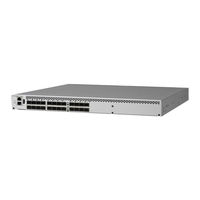HP Fabric OS v7.0.1 Manuals
Manuals and User Guides for HP Fabric OS v7.0.1. We have 1 HP Fabric OS v7.0.1 manual available for free PDF download: Administrator's Manual
HP Fabric OS v7.0.1 Administrator's Manual (584 pages)
Brocade Fabric OS Administrator's Guide - Supporting Fabric OS v7.0.1 (53-1002446-01, March 2012)
Table of Contents
-
-
Device Login48
-
-
Domain Ids66
-
Switch Names68
-
Fabric Name69
-
-
Ports77
-
-
In this Chapter101
-
Routing Overview101
-
Fspf102
-
Gateway Links106
-
Routing Policies108
-
Route Selection110
-
-
-
In this Chapter119
-
-
Creating a Group148
-
-
-
In this Chapter153
-
Secure Copy154
-
Telnet Protocol165
-
Blocking Telnet165
-
-
-
-
In this Chapter169
-
-
FCS Policies173
-
DCC Policies176
-
SCC Policies180
-
-
IP Filter Policy191
-
-
-
Ipsec Protocols206
-
IKE Policies208
-
Ipsec Policies208
-
Key Management209
-
-
-
In this Chapter215
-
-
-
In this Chapter229
-
FIPS Support240
-
-
-
In this Chapter249
-
-
-
-
-
-
-
In this Chapter275
-
Special Zones275
-
Zoning Overview276
-
Zone Objects278
-
Zone Aliases279
-
Broadcast Zones282
-
Zone Aliases284
-
-
Zone Merging301
-
Table 53 Table303
-
-
-
In this Chapter307
-
-
TI Zone Failover308
-
Figure 40 Figure311
-
-
-
-
In this Chapter335
-
-
Detection338
-
-
-
In this Chapter347
-
-
Chapter 15 NPIV
361 -
-
In this Chapter367
-
-
-
In this Chapter375
-
-
-
-
-
-
In this Chapter405
-
ICL Licensing412
-
8G Licensing414
-
10G Licensing415
-
Ports on Demand423
-
-
-
In this Chapter431
-
-
-
In this Chapter437
-
-
Frame Monitoring444
-
-
Trunk Monitoring453
-
-
-
In this Chapter455
-
Qos Zones462
-
-
-
In this Chapter471
-
Ex_Port Trunking478
-
F_Port Trunking480
-
-
-
In this Chapter489
-
-
-
-
In this Chapter503
-
-
Proxy Devices509
-
Phantom Domains511
-
-
-
-
In this Appendix545
-
Port Indexing555
-
-
-
FIPS Support559
-
-
-
In this Appendix559
-
FIPS Overview559
-
-
-
Index573
-
Advertisement
Advertisement
Related Products
- HP Fabric OS 6.2.2e
- HP StorageWorks Fabric OS 3.x
- HP StorageWorks Fabric OS 3.1.x
- HP StorageWorks Fabric OS 5 Advanced Web Tools
- HP StorageWorks Fabric OS 5.x
- HP StorageWorks Fabric OS 6.1.2b
- HP StorageWorks Fabric OS 6.2.0b
- HP StorageWorks Fabric OS 3.1
- HP StorageWorks Secure Fabric OS 1.0
- HP StorageWorks Fabric OS 6.2.0g
